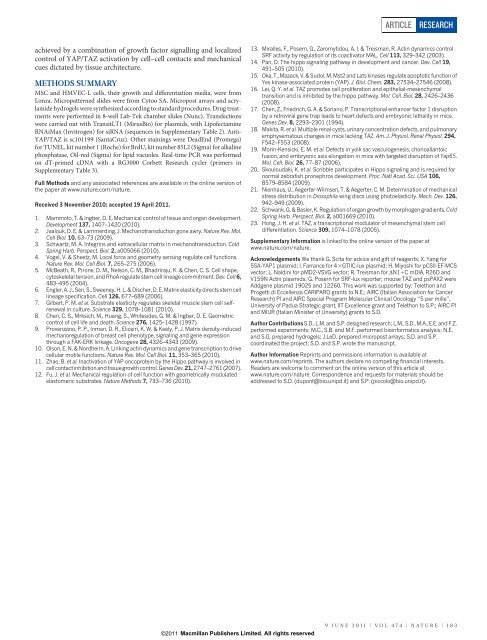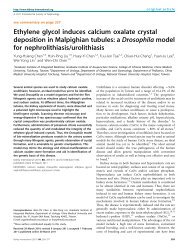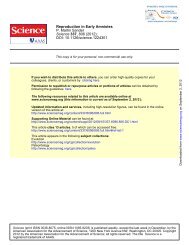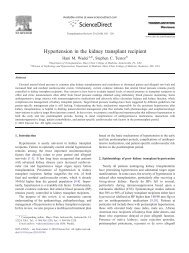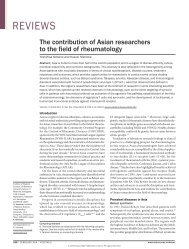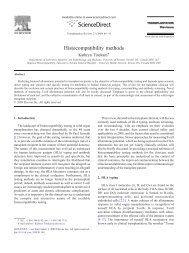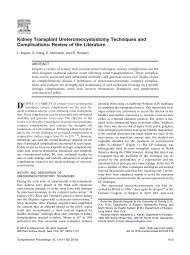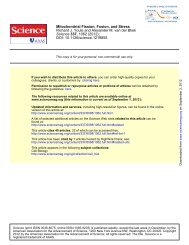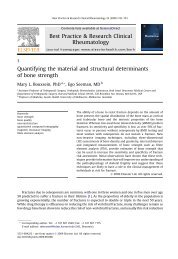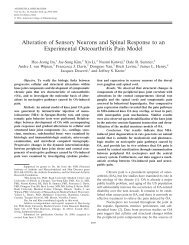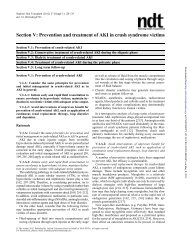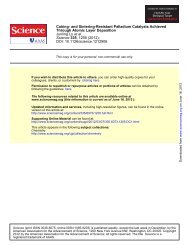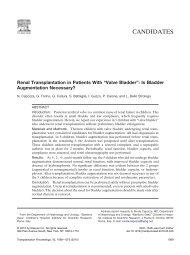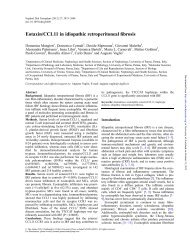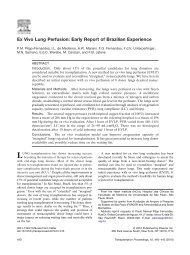Role of YAP/TAZ in mechanotransduction
Role of YAP/TAZ in mechanotransduction
Role of YAP/TAZ in mechanotransduction
You also want an ePaper? Increase the reach of your titles
YUMPU automatically turns print PDFs into web optimized ePapers that Google loves.
achieved by a comb<strong>in</strong>ation <strong>of</strong> growth factor signall<strong>in</strong>g and localized<br />
control <strong>of</strong> <strong>YAP</strong>/<strong>TAZ</strong> activation by cell–cell contacts and mechanical<br />
cues dictated by tissue architecture.<br />
METHODS SUMMARY<br />
MSC and HMVEC-L cells, their growth and differentiation media, were from<br />
Lonza. Micropatterned slides were from Cytoo SA. Micropost arrays and acrylamide<br />
hydrogels were synthesized accord<strong>in</strong>g to standard procedures. Drug treatments<br />
were performed <strong>in</strong> 8-well Lab-Tek chamber slides (Nunc). Transfections<br />
were carried out with TransitLT1 (MirusBio) for plasmids, with Lip<strong>of</strong>ectam<strong>in</strong>e<br />
RNAiMax (Invitrogen) for siRNA (sequences <strong>in</strong> Supplementary Table 2). Anti-<br />
<strong>YAP</strong>/<strong>TAZ</strong> is sc101199 (SantaCruz). Other sta<strong>in</strong><strong>in</strong>gs were DeadEnd (Promega)<br />
for TUNEL, kit number 1 (Roche) for BrdU, kit number 85L2 (Sigma) for alkal<strong>in</strong>e<br />
phosphatase, Oil-red (Sigma) for lipid vacuoles. Real-time PCR was performed<br />
on dT-primed cDNA with a RG3000 Corbett Research cycler (primers <strong>in</strong><br />
Supplementary Table 3).<br />
Full Methods and any associated references are available <strong>in</strong> the onl<strong>in</strong>e version <strong>of</strong><br />
the paper at www.nature.com/nature.<br />
Received 3 November 2010; accepted 19 April 2011.<br />
1. Mammoto, T. & Ingber, D. E. Mechanical control <strong>of</strong> tissue and organ development.<br />
Development 137, 1407–1420 (2010).<br />
2. Jaalouk, D. E. & Lammerd<strong>in</strong>g, J. Mechanotransduction gone awry. Nature Rev. Mol.<br />
Cell Biol. 10, 63–73 (2009).<br />
3. Schwartz, M. A. Integr<strong>in</strong>s and extracellular matrix <strong>in</strong> <strong>mechanotransduction</strong>. Cold<br />
Spr<strong>in</strong>g Harb. Perspect. Biol. 2, a005066 (2010).<br />
4. Vogel, V. & Sheetz, M. Local force and geometry sens<strong>in</strong>g regulate cell functions.<br />
Nature Rev. Mol. Cell Biol. 7, 265–275 (2006).<br />
5. McBeath, R., Pirone, D. M., Nelson, C. M., Bhadriraju, K. & Chen, C. S. Cell shape,<br />
cytoskeletal tension, and RhoA regulate stem cell l<strong>in</strong>eage commitment. Dev. Cell 6,<br />
483–495 (2004).<br />
6. Engler, A. J., Sen, S., Sweeney, H. L. & Discher, D. E. Matrix elasticity directs stem cell<br />
l<strong>in</strong>eage specification. Cell 126, 677–689 (2006).<br />
7. Gilbert, P. M. et al. Substrate elasticity regulates skeletal muscle stem cell selfrenewal<br />
<strong>in</strong> culture. Science 329, 1078–1081 (2010).<br />
8. Chen, C. S., Mrksich, M., Huang, S., Whitesides, G. M. & Ingber, D. E. Geometric<br />
control <strong>of</strong> cell life and death. Science 276, 1425–1428 (1997).<br />
9. Provenzano, P. P., Inman, D. R., Eliceiri, K. W. & Keely, P. J. Matrix density-<strong>in</strong>duced<br />
mechanoregulation <strong>of</strong> breast cell phenotype, signal<strong>in</strong>g and gene expression<br />
through a FAK-ERK l<strong>in</strong>kage. Oncogene 28, 4326–4343 (2009).<br />
10. Olson, E. N. & Nordheim, A. L<strong>in</strong>k<strong>in</strong>g act<strong>in</strong> dynamics and gene transcription to drive<br />
cellular motile functions. Nature Rev. Mol. Cell Biol. 11, 353–365 (2010).<br />
11. Zhao, B. et al. Inactivation <strong>of</strong> <strong>YAP</strong> oncoprote<strong>in</strong> by the Hippo pathway is <strong>in</strong>volved <strong>in</strong><br />
cell contact<strong>in</strong>hibition and tissuegrowthcontrol. Genes Dev. 21, 2747–2761 (2007).<br />
12. Fu, J. et al. Mechanical regulation <strong>of</strong> cell function with geometrically modulated<br />
elastomeric substrates. Nature Methods 7, 733–736 (2010).<br />
©2011<br />
Macmillan Publishers Limited. All rights reserved<br />
ARTICLE RESEARCH<br />
13. Miralles, F., Posern, G., Zaromytidou, A. I. & Treisman, R. Act<strong>in</strong> dynamics control<br />
SRF activity by regulation <strong>of</strong> its coactivator MAL. Cell 113, 329–342 (2003).<br />
14. Pan, D. The hippo signal<strong>in</strong>g pathway <strong>in</strong> development and cancer. Dev. Cell 19,<br />
491–505 (2010).<br />
15. Oka, T., Mazack, V. & Sudol, M. Mst2 and Lats k<strong>in</strong>ases regulate apoptotic function <strong>of</strong><br />
Yes k<strong>in</strong>ase-associated prote<strong>in</strong> (<strong>YAP</strong>). J. Biol. Chem. 283, 27534–27546 (2008).<br />
16. Lei, Q. Y. et al. <strong>TAZ</strong> promotes cell proliferation and epithelial-mesenchymal<br />
transition and is <strong>in</strong>hibited by the hippo pathway. Mol. Cell. Biol. 28, 2426–2436<br />
(2008).<br />
17. Chen, Z., Friedrich, G. A. & Soriano, P. Transcriptional enhancer factor 1 disruption<br />
by a retroviral gene trap leads to heart defects and embryonic lethality <strong>in</strong> mice.<br />
Genes Dev. 8, 2293–2301 (1994).<br />
18. Makita, R. et al. Multiple renal cysts, ur<strong>in</strong>ary concentration defects, and pulmonary<br />
emphysematous changes <strong>in</strong> mice lack<strong>in</strong>g <strong>TAZ</strong>. Am. J. Physiol. Renal Physiol. 294,<br />
F542–F553 (2008).<br />
19. Mor<strong>in</strong>-Kensicki, E. M. et al. Defects <strong>in</strong> yolk sac vasculogenesis, chorioallantoic<br />
fusion, and embryonic axis elongation <strong>in</strong> mice with targeted disruption <strong>of</strong> Yap65.<br />
Mol. Cell. Biol. 26, 77–87 (2006).<br />
20. Skouloudaki, K. et al. Scribble participates <strong>in</strong> Hippo signal<strong>in</strong>g and is required for<br />
normal zebrafish pronephros development. Proc. Natl Acad. Sci. USA 106,<br />
8579–8584 (2009).<br />
21. Nienhaus, U., Aegerter-Wilmsen, T. & Aegerter, C. M. Determ<strong>in</strong>ation <strong>of</strong> mechanical<br />
stress distribution <strong>in</strong> Drosophila w<strong>in</strong>g discs us<strong>in</strong>g photoelasticity. Mech. Dev. 126,<br />
942–949 (2009).<br />
22. Schwank, G. & Basler, K. Regulation <strong>of</strong> organ growth by morphogen gradients. Cold<br />
Spr<strong>in</strong>g Harb. Perspect. Biol. 2, a001669 (2010).<br />
23. Hong, J. H. et al. <strong>TAZ</strong>, a transcriptional modulator <strong>of</strong> mesenchymal stem cell<br />
differentiation. Science 309, 1074–1078 (2005).<br />
Supplementary Information is l<strong>in</strong>ked to the onl<strong>in</strong>e version <strong>of</strong> the paper at<br />
www.nature.com/nature.<br />
Acknowledgements We thank G. Scita for advice and gift <strong>of</strong> reagents; X. Yang for<br />
5SA-<strong>YAP</strong>1 plasmid; I. Farrance for 43GTIIC-lux plasmid; H. Miyoshi for pCSII-EF-MCS<br />
vector; L. Nald<strong>in</strong>i for pMD2-VSVG vector; R. Treisman for DN11C mDIA, R26D and<br />
V159N Act<strong>in</strong> plasmids; G. Posern for SRF-lux reporter; mouse <strong>TAZ</strong> and psPAX2 were<br />
Addgene plasmid 19025 and 12260. This work was supported by: Telethon and<br />
Progetti di Eccellenza CARIPARO grants to N.E.; AIRC (Italian Association for Cancer<br />
Research) PI and AIRC Special Program Molecular Cl<strong>in</strong>ical Oncology ‘‘5 per mille’’,<br />
University <strong>of</strong> Padua Strategic grant, IIT Excellence grant and Telethon to S.P.; AIRC PI<br />
and MIUR (Italian M<strong>in</strong>ister <strong>of</strong> University) grants to S.D.<br />
Author Contributions S.D., L.M. and S.P. designed research; L.M., S.D., M.A., E.E. and F.Z.<br />
performed experiments; M.C., S.B. and M.F. performed bio<strong>in</strong>formatics analysis; N.E.<br />
and S.G. prepared hydrogels; J.LeD. prepared micropost arrays; S.D. and S.P.<br />
coord<strong>in</strong>ated the project; S.D. and S.P. wrote the manuscript.<br />
Author Information Repr<strong>in</strong>ts and permissions <strong>in</strong>formation is available at<br />
www.nature.com/repr<strong>in</strong>ts. The authors declare no compet<strong>in</strong>g f<strong>in</strong>ancial <strong>in</strong>terests.<br />
Readers are welcome to comment on the onl<strong>in</strong>e version <strong>of</strong> this article at<br />
www.nature.com/nature. Correspondence and requests for materials should be<br />
addressed to S.D. (dupont@bio.unipd.it) and S.P. (piccolo@bio.unipd.it).<br />
9 J U N E 2 0 1 1 | V O L 4 7 4 | N AT U R E | 1 8 3


